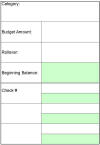|
Family Budget Strategy Like almost everyone, my wife Jerrie and I struggled to
manage our family budget. We tried a variety of disappointing strategies.
One of the smartest things I ever did was to turn the check book and the
budget over to her.
When we discovered the book called "Rich
on Any Income," it gave us a strategy that really worked for us. The
book included a supply of unique budget forms, which fit into our checkbook.
The basic concept involved a spending plan, which reserved a part of our
regular paycheck into various expense categories for anticipated bills.
Using this strategy, when the annual property tax statement came, we had
accumulated enough money in its category to pay the bill.
We taught the strategy to our children and shared the ideas
with family and friends. Then in 2003 we were asked to teach a lesson on
how to use a family budget at our local church. We prepared two handouts
for the lesson:

1. A little workbook entitled "How
to Thrive on Your Income." It helped identify spendable income and
create a spending plan.

2. A "Spending
Plan Worksheet" to be used to track spending-category budgets,
expenditures, and balances. It could be folded a certain way and kept
conveniently in a checkbook.
During the class we learned that some people
followed dangerous practices, such as keeping no record of written checks,
relying only on monthly bank statements to gauge how much money they could
spend. Others used credit cards extensively and seemed to worry more about
their credit limit than their ability to make minimum payments.
We were impressed with one mother who had a cash budgeting
system that worked very much like ours. When she got money, she literally sorted cash
into envelopes. Each envelope was for a specific purpose. When she needed
money for something, she would look in the appropriate envelope. If there
was money in the envelope she might spend part of it. If the money was gone,
she wouldn't spend. Even though she had very little income, she knew her spending
patterns and divided her money accordingly. She always knew where she stood
financially. Click
here to see a brief outline describing how to use this budgeting system.
[Top] [Back]
[Home]
|